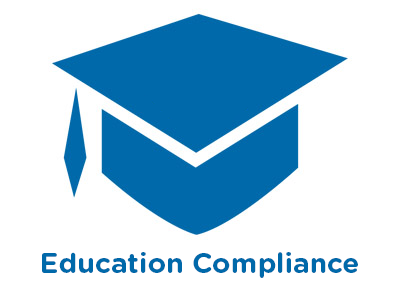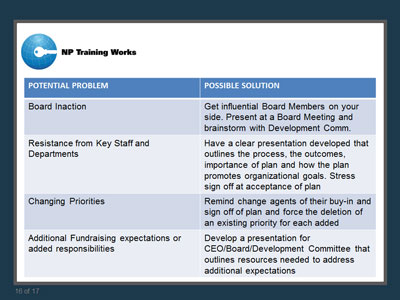 |
Course 10: School-Age Care as a Family Service – Part Two |
2.00 |
The foundation for getting parents involved in school-age programs is to keep parents well informed about what is happening in the program. Quality programs also provide parents with opportunities to make suggestions and give feedback on program services through suggestion boxes, feedback forms, and surveys. When parents are encouraged to have input in the program, they develop trust and confidence in the program and feel a sense of pride and ownership. They are much more likely to participate as resourceful partners with program staff when they know their ideas are welcome and valued. Finally, because parents are all different from each other, it’s important to provide many different opportunities for them to connect with the program. Staff in quality school-age programs recognize that all parents don’t have to be involved in the same way. |
 |
School-Age Care as a Family Service: Emphasis on Planning Opportunities for Family Involvement |
2.00 |
The foundation for getting parents involved in school-age programs is to keep parents well informed about what is happening in the program. Quality programs also provide parents with opportunities to make suggestions and give feedback on program services through suggestion boxes, feedback forms, and surveys. When parents are encouraged to have input in the program, they develop trust and confidence in the program, and feel a sense of pride and ownership. They are more likely to participate as resourceful partners with program staff when they know their ideas are welcome and valued. Finally, because parents are all different from each other, it's important to provide many different opportunities for them to connect with the program. Staff in quality school-age programs recognize that all parents don't have to be involved in the same way. |
 |
Neonatal Mammal Care |
2.50 |
The goal of this course (and final exam) is to explore the importance of neonatal assisted care and the role it plays in protecting species in managed care and the struggle to save species from extinction. |
 |
Sexual Harassment Prevention: Understanding Management Issues |
0.25 |
The goal of this course is to assess the need for a sexual harassment policy in an organization and respond appropriately to a sexual harassment accusation. |
 |
Mindfulness |
1.00 |
The goal of this course is to educate caregivers about the benefits of incorporating mindfulness into the activities of elderly care patients. Practicing mindfulness can promote improvements in both physical and psychological symptoms as well as positive changes in health attitudes and behaviors in both elderly care patients and caregivers alike.
|
 |
Superskilled: Reducing Turnover and Increasing Retention |
1.00 |
The goal of this course is to help you gain understanding and insight on the importance of promoting life skills training for agencies employing home health care paraprofessionals. Life skills training is a way to help the home health care agencies reduce turnover and increase retention of the home health care paraprofessional. |
 |
Sexual Harassment Prevention: Recognizing Harassing Behavior |
0.33 |
The goal of this course is to identify behavior that constitutes sexual harassment and understand the impact of sexual harassment in the workplace. |
 |
Ending Extinction: The Basics - Module 1 |
2.50 |
The goal of this course is to lead the fight against extinction by taking a leadership role and collaborating with others to save species from extinction using science-based techniques and fostering collaboration and cooperation. |
 |
Ending Extinction: The Basics - Module 2 |
2.50 |
The goal of this course is to lead the fight against extinction by taking a leadership role and collaborating with others to save species from extinction using science-based techniques and fostering collaboration and cooperation. |
 |
Plant Conservation |
2.50 |
The goal of this course is to lead the fight against extinction by taking a leadership role and collaborating with others to save species from extinction using science-based techniques and fostering collaboration and cooperation. |
 |
Geriatric Oncology |
1.00 |
The goal of this course is to review the role of geriatric assessment in the older cancer population and how geriatric assessment can be used to predict chemotherapy toxicity and influence decision-making in this population. |
 |
Organizational Communication: Technology in the Workplace (Instructor Guide) |
0.84 |
The impact of technology has sped up the communication process in organizations. As a result, communication can occur at any time and place. To facilitate effective communication in an organization, you need to identify and use different communication technologies.
In this course you will learn to: identify the various categories of technologies, identify the impact of technology on organizations, and identify the guidelines for applying technology in an organization.
This Instructor's Edition of this course includes notes and suggestions to assist you in presenting the material, whether in an in-person classroom setting, or as an instructor-led online or distance-learning course. It also provides you with the answers to questions found in mid-lesson activities, as well as in the quiz that concludes the course. |
 |
Organizational Communication: Technology in the Workplace |
0.84 |
The impact of technology has sped up the communication process in organizations. As a result, communication can occur at any time and place. To facilitate effective communication in an organization, you need to identify and use different communication technologies.
In this course you will learn to: identify the various categories of technologies, identify the impact of technology on organizations, and identify the guidelines for applying technology in an organization. |
 |
Universal Design: Providing Accessibility to All (Webinar) |
1.00 |
The intent of Universal Design is to provide what is considered “Life Span” or “Barrier Free” designs. That means that products and the built environment are designed in a way that everyone is able to use it, no matter a person’s age or ability. The design is not only intended for a person with a disability but also for a child or shorter adult to easily use and provided in an inclusive way. This session will review the history of Universal Design, what makes it different and more effective than present accessibility codes and examples of how these can be included into zoo, aquarium and museum designs. |
 |
A Student Guide to the Clery Act |
0.50 |
The Jeanne Clery Disclosure of Campus Security Policy and Campus Crime Statistics Act, commonly known as the Clery Act, is a federal law that requires colleges and universities to track and disclose information about crimes that occur on or near campus. This course is designed to help students understand how the Clery Act impacts them and their school. |
 |
Writing the Annual Development Plan |
1.00 |
The key to success in any Development department is having a solid plan. Development Planning helps you stay on task and stick to your goals when everyone is pulling you in multiple directions. Planning also gives you the option to be flexible when necessary. In this Webinar you will learn the key elements of a successful Annual Development Plan and have a toolkit for your own planning. This Webinar will help you: understand the development function and how it interacts with, and relates to the functions of other departments; create a development philosophy that guides your overall vision for success; set development goals; create action plans for each area of responsibility within the development function; create donor contact plans; understand the various development categories and identify the categories you are responsible for in your organization; and, identify material needs for your development office, download examples of materials and edit them for your own use.
|
 |
Course 06: Guiding the Behavior of Individual Children |
2.00 |
The knowledge and understanding in this course will help students develop strategies for creating programs that encourage individual children to develop self-discipline and self-direction, establish positive relationships with others, and exhibit respect for program materials and equipment and the rights of others. |
 |
Sexual Harassment Prevention: Understanding Legal Issues |
0.25 |
The learning objective for this course is to describe the law against sexual harassment and understand an organization’s liability if a non-employee harasses an employee. |
 |
Sexual Harassment Prevention: Defining Sexual Harassment |
0.25 |
The learning objectives for this course are to avoid sexually harassing behavior and realize the cost of sexual harassment to an organization and to identify the psychological, health-related, and career-related effects of sexual harassment. |
 |
Cheetahs |
1.00 |
The module covers an overview of cheetah physical characteristics, distribution and habitat, behavior and ecology, and reproduction as well as important conservation efforts dedicated its protection. Remarkable images show cheetahs in ways you’ve never seen before, and video provides insights into their behavior. |
 |
Motivation: Identifying, Planning, and Implementing: The Motivation Process (Instructor Guide) |
1.00 |
The motivation process involves four phases: identifying, planning, implementing, and evaluating. Each phase is distinct, but you will notice that the process is arranged in a continuous circle, because it is ongoing.
In this course you will learn to: identify your goals and plan the necessary steps to reach these goals, and implement your plan and evaluate its progress to strive for peak performance levels.
This Instructor's Edition of this course includes notes and suggestions to assist you in presenting the material, whether in an in-person classroom setting, or as an instructor-led online or distance-learning course. It also provides you with the answers to questions found in mid-lesson activities, as well as in the quiz that concludes the course. |
 |
Motivation: Identifying, Planning, and Implementing: The Motivation Process |
1.00 |
The motivation process involves four phases: identifying, planning, implementing, and evaluating. Each phase is distinct, but you will notice that the process is arranged in a continuous circle, because it is ongoing.
In this course you will learn to: identify your goals and plan the necessary steps to reach these goals, and implement your plan and evaluate its progress to strive for peak performance levels. |
 |
Course 23: Providing Homework Support |
2.00 |
The National Standard Objectives of Learning (SOL) have raised questions about the role of school-age programs in providing homework help and support. Research indicates there are many different ways to provide effective homework support in school-age programs. Some are more structured than others. When planning a homework support program, it is important for school-age programs to develop a homework philosophy that is consistent with the program’s overall philosophy and reflects current research on best practices for providing homework help. The homework philosophy should also reflect the needs of parents and children in the program and strike a balance between homework needs and other experiences that help children grow and learn out-of-school. When staff know how to design homework environments, identify appropriate homework materials, and use effective strategies to guide children’s efforts, homework support can be an effective component of ongoing programs. |
 |
Providing Homework Support (Collection) |
2.00 |
The National Standard Objectives of Learning (SOL) have raised questions about the role of school-age programs in providing homework help and support. Research indicates there are many different ways to provide effective homework support in school-age programs. Some are more structured than others. When planning a homework support program, it is important for school-age programs to develop a homework philosophy that is consistent with the program’s overall philosophy and reflects current research on best practices for providing homework help. The homework philosophy should also reflect the needs of parents and children in the program and strike a balance between homework needs and other experiences that help children grow and learn out-of-school. When staff know how to design homework environments, identify appropriate homework materials, and use effective strategies to guide children’s efforts, homework support can be an effective component of ongoing programs. |
 |
Providing Homework Support |
2.00 |
The National Standard Objectives of Learning (SOL) have raised questions about the role of school-age programs in providing homework help and support. Research indicates there are many different ways to provide effective homework support in school-age programs. Some are more structured than others. When planning a homework support program, it is important for school-age programs to develop a homework philosophy that is consistent with the program’s overall philosophy and reflects current research on best practices for providing homework help. The homework philosophy should also reflect the needs of parents and children in the program and strike a balance between homework needs and other experiences that help children grow and learn out-of-school. When staff know how to design homework environments, identify appropriate homework materials, and use effective strategies to guide children’s efforts, homework support can be an effective component of ongoing programs. |


























